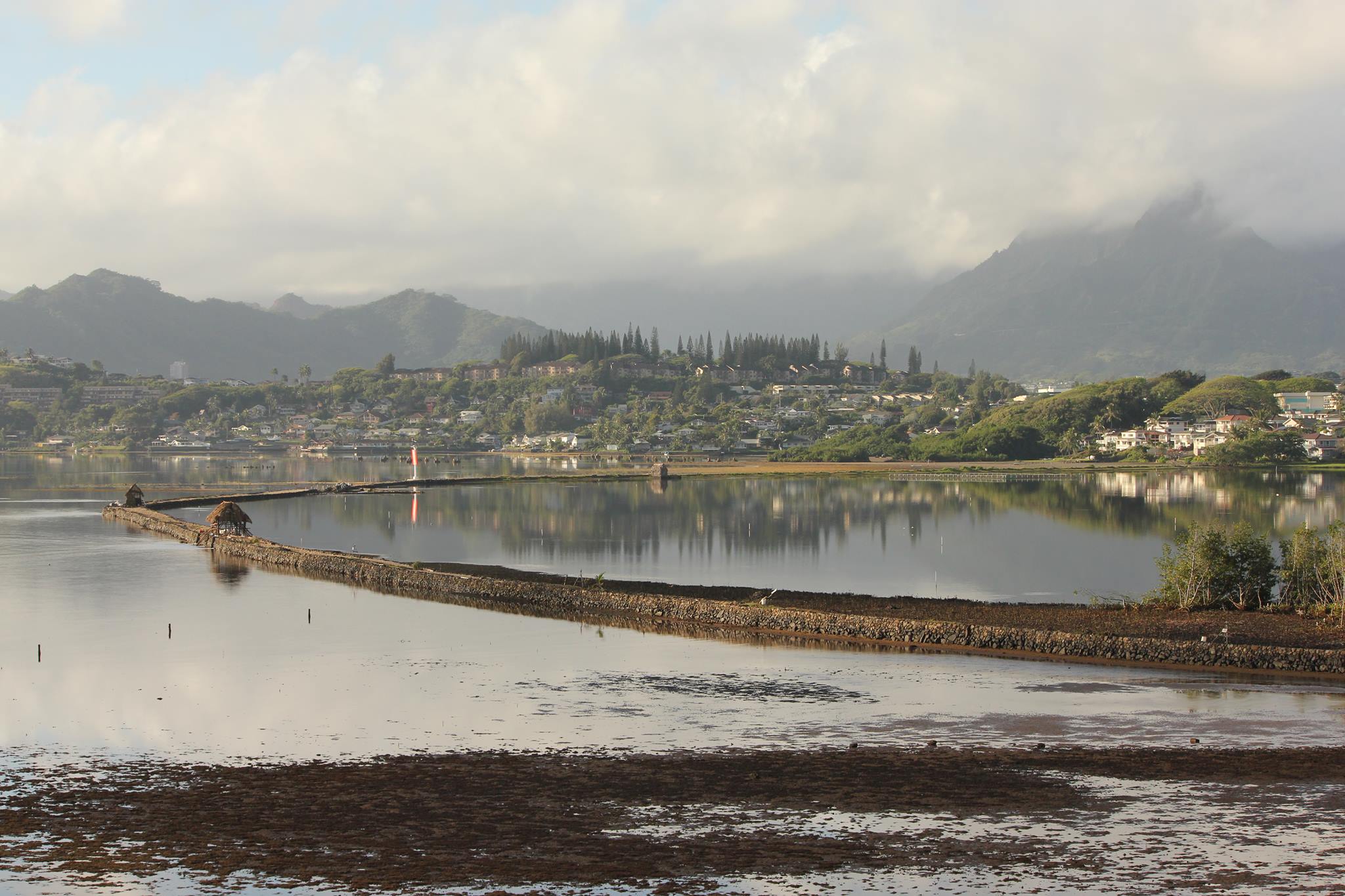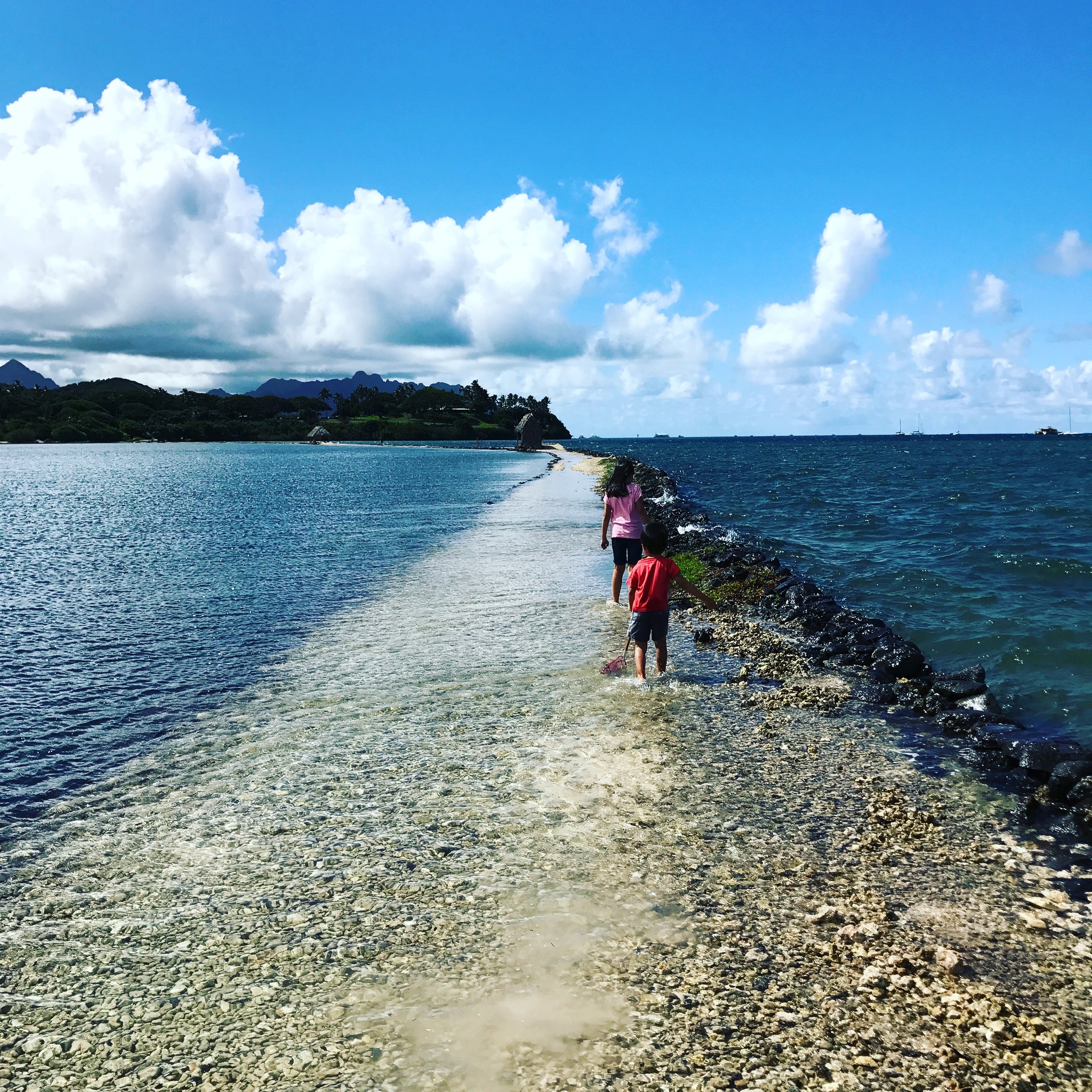Research at He‘eia Fishpond is principally focused around the following interrelated themes of inquiry:
LAND-SEA INTERACTIONS
Image source: Paepae o He'eia
- How does stream input impact the geochemistry, biology and ecology of the fishpond?
What has been the impact on the health of the He‘eia Fishpond ecosystem of enhanced urban development within the watershed, and resultant increased sediment and nutrient delivery to the coastal ocean?
How will anticipated changes in land-use within the watershed impact the physical, biogeochemical and ecological functioning of He‘eia Fishpond?
- How does the restoration of the fishpond increase coastal resilience, through protection from floods and land based runoff?
Support
Lo`i Kalo as Retention Basins: A New Approach to Designing Constructed Wetlands in Hawaiʻi, CWRM Water Security, DLNR. PI: K. Falinski. 2017.
The Role of Microbes in Nutrient Cycling in Heʻeia Fishpond, Sea Grant Project Development Grant No: NA09OAR4170060. PI: RA Alegado. January 1, 2014 - December 31, 2014.
RESTORATION ECOLOGY
How do macroalgae affect nutrient cycling and bioavailability?
- How do mangroves alter the physics and geochemistry of the benthic environment, and what impact will mangrove removal have on pond geochemistry, biology and ecology?
- What have been the impacts of invasive algae on bioavailable nutrients, and the consequent ecosystem response?
SUPPORT
Heʻeia Fishpond Mangrove Removal and Water Quality Improvement, Hawaiʻi State Department of Health, Clean Water Branch, PI: M. Walton (UHM SOEST/Sea Grant), Co-I: Alegado (UHM SOEST/OCN), March 1, 2017–February 28, 2019
Restoration of a Hawaiian wetland and stream in Heʻeia, O‘ahu to increase ecosystem and community resilience. NOAA Coastal Resilience. PI: K. Falinski, Co-I: K. Shultz (TNC), January 1, 2017 – Dec 31, 2019.
Impact of mangrove removal on benthic sediment dynamics and redox state in a marine coastal pond: He‘eia Fishpond, O‘ahu, Hawai‘i, Sea Grant Project Development Grant No: NA09OAR4170060, Project No: R/HE-23PD, PI: KC Ruttenberg, AI: M McManus, April 1, 2014 – March 31, 2015.
Biogeochemical monitoring of the impacts of invasive mangrove removal and potential El Nino effects on He’eia Fishpond, Sea Grant Project Development, PIs: B. Glazer and KC Ruttenberg, Sept. 15, 2014 – Aug 31, 2015.
Pilot mangrove removal project, Paepae O He’eia, PI: KC Ruttenberg, March 2011-November 2014.
Image Source: Paula Moehlenkamp
IMPACTS OF GLOBAL CHANGE ON COASTAL OCEANS
- What are the observed seasonal and longer timescale patterns of the physical and biogeochemical environment, what are the processes responsible for the observed patterns
- How do temporal shifts in the near-field and far-field environment impact the ecology of the fishpond?
- How does nutrient input vary between the rainy season versus dry season, and how what is the magnitude and duration of storm nutrient input on the biogeochemistry of the pond?
- How does climate change, including cyclical climate variability (e.g., ENSO cycles, PDO), and longer-term change, impact the physical, biogeochemical and ecological functioning of He‘eia Fishpond?
SUPPORT
Influence of anthropogenic and climatic forcing on water quality within a tropical coastal ecosystem, USGS State Water Resources Research Institute Program, PI: R Alegado, February 1, 2016 – January 31, 2018
Biogeochemical monitoring of the impacts of invasive mangrove removal and potential El Nino effects on He’eia Fishpond, Sea Grant Project Development Grant, PIs: B. Glazer and KC Ruttenberg, Sept. 15, 2014 – Aug 31, 2015.
Linking physical variability to the geochemistry and biology of He‘eia Fishpond, Sea Grant Project Development Grant No: NA09OAR4170060, Project No: R/HE-24PD PIs: M McManus and KC Ruttenberg, April 1, 2014 – March 31, 2015.
Image Source: ROSIE ALEGADO
BENTHIC-PELAGIC COUPLING
image source: Kiana Frank
- How do pond bottom (benthic) sediments influence nutrient cycling in the water column, and what impact do these processes have on fishpond biology and ecology?
- What is the role of bottom sediments in providing or sequestering bioavailable nutrients to the pelagic biological community?
Support
Linking biogeochemical sulfur and iron cycling with the diversity and activity of benthic microbes in coastal Hawaiian marine environments. NSF OCE Postdoctoral Fellowship. PI. K Frank. Research Collaborators: RA Alegado, KC Ruttenberg, M McManus, K Rogers (RPI). July 1, 2014 - June 30, 2016.
The Role of Bottom Sediments in Nutrient Cycling in He’eia Fishpond – II. Sea Grant Project No: R/AQ-84, PI: KC Ruttenberg, AI: M McManus and B Glazer, Feb 1, 2009 – Jan 1, 2011.
The Role of Bottom Sediments in Nutrient Cycling in He’eia Fishpond. Sea Grant Project No: R/EL-42, PI: KC Ruttenberg, AI: M McManus and B Glazer, Feb 1, 2007 – Jan 1, 2009
OTHER MAJOR PROJECTS
NSF-OEDG Track I Proposal: Laulima A ‘Ike Pono – Community Collaborations in Geosciences and Place-based Education. Start date 11/1/09 – 10/31/13, PI: Judith Lemus (HIMB), Co-PIs: K. Ruttenberg (OCN), Florence Thomas (HIMB).




